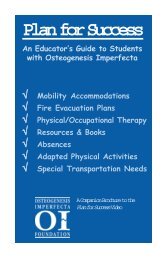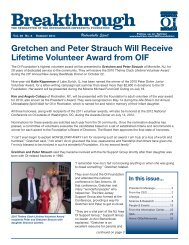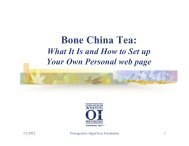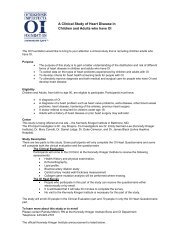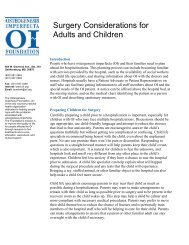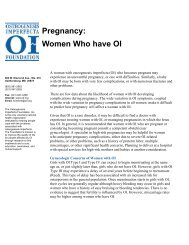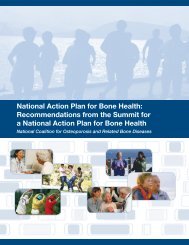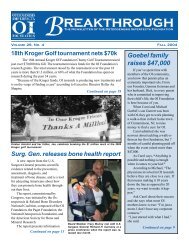Breakthrough - Osteogenesis Imperfecta Foundation
Breakthrough - Osteogenesis Imperfecta Foundation
Breakthrough - Osteogenesis Imperfecta Foundation
You also want an ePaper? Increase the reach of your titles
YUMPU automatically turns print PDFs into web optimized ePapers that Google loves.
Spotlight<br />
Physical therapy brings relief from pain for mother of two<br />
Kathleen Kowis has what she calls “severe Type I OI.”<br />
In fact, when her type was diagnosed through genetic<br />
testing, the results suprised her family and doctors, who had<br />
placed her as a more severe type based on her symptoms<br />
and medical history.<br />
“In spite of that, I’m not sure I did everything I could do<br />
growing up to stay healthy,” Kathleen confessed. “I guess<br />
the mindset was ‘if I’m not breaking, why see a doctor?’”<br />
When Kathleen was near the end of her second pregnancy,<br />
the pain in her<br />
knee was so bad she<br />
couldn’t stand, much<br />
less walk, maintain her<br />
household, and care for<br />
her infant daughter.<br />
“It was probably the<br />
additional weight I was<br />
carrying due to the pregnancy,” she recalled, “but I had also<br />
fallen and fractured that kneecap 5 years earlier.”<br />
Complicating matters, a job opportunity for her huband,<br />
Greg, took their brand-new family to N.C., too far from<br />
extended family for them to be able to receive regular<br />
support and assistance.<br />
Visits to local doctors unfamiliar with OI were not reassuring.<br />
One looked at her x-rays and informed her she had<br />
“83 year-old looking knees.” She was told to stop walking<br />
on it, not to exercise, and to consider having a knee replacement<br />
surgery that couldn’t guarantee results.<br />
“It was frightening,” Kathleen said. “When Sean was<br />
born, the pain was bad enough that I was too scared to<br />
carry him. I was dragging him around the house in his<br />
bassinet!”<br />
By the time her knee pain was bad enough to send her in<br />
search of help, she had tendon and ligament damage as well<br />
as damage to the bones in her knees.<br />
Kathleen traveled to Baltimore to meet with Dr. Shapiro<br />
(a member of the OI <strong>Foundation</strong>’s medical advisory council)<br />
and a group of specialists at the OI Clinic at Kennedy<br />
Kreiger, who recommended physical therapy as a means of<br />
controlling the pain.<br />
“It turns out there were a series of problems, and not just<br />
in the knee,” Kathleen said.<br />
One of the biggest contributing factors to the knee<br />
problems turned out to be the curvature in her legs due to<br />
repeated micro-fractures through the years. The bowing<br />
was turning her foot, impacting her gait and adding stress to<br />
the knees.<br />
“A simple insert in my shoe from the physical therapist<br />
made a world of difference,” Kathleen said. “In fact, when<br />
I walk barefoot— without the special insert— I can notice<br />
the increased pain immediately.”<br />
However, her physical therapy was more involved than<br />
just the insert. Kathleen spent months receiving special antiinflammatory<br />
treatments using electrodes to draw the<br />
medication to the right spots in her knees. She also was<br />
taught a series of mild exercises to help strengthen the<br />
muscles supporting her knees.<br />
“It could have been much worse, and I might have<br />
resorted to surgery,” she said. “Nobody was giving me any<br />
options other than<br />
that until I met with<br />
“I never saw a physical therapist as a child, and<br />
believe it really would have made a difference.<br />
I’d like to assume all kids with OI today have one.”<br />
Dr. Shapiro and the<br />
team at the OI<br />
Clinic.”<br />
She said hard<br />
work brought her<br />
success in managing<br />
the pain without surgery. It required lots of research, selfeducation<br />
about the issue, and three or four opinions from<br />
different doctors before she was ready to make a decision<br />
about how to treat the pain.<br />
“I learned through all this that you have to stick to it and<br />
not give up when you come across a medical problem. You<br />
simply have to keep fighting until you find someone who is<br />
willing to work with you,” she explained.<br />
“Surgery is not necessarily a pain management tool,” she<br />
said. “Once I found someone knowledgeable about OI and<br />
willing to listen to what I’d learned, more options were<br />
available to me. It was almost like I had to be my own<br />
health advocate.”<br />
Today Kathleen relies on yoga to control stress and water<br />
therapy to stay strong, takes the occasional anti-inflammatory<br />
medication when needed, and regularly meets with a<br />
physical therapist.<br />
“I never saw a physical therapist as a child,” she said,<br />
“and believe it really would have made a difference. I’d like<br />
to assume all kids with OI today have one.”<br />
She believes that some simple exercises and early interaction<br />
with “the right people” could make all the difference<br />
in whether or not children suffer from joint pain as adults.<br />
“But most of all you have to know yourself, and search<br />
for as many options and as much information as you<br />
possibly can,” she said.<br />
The pain’s not completely gone, and Kathleen has to be<br />
diligent with sticking to her exercises and using the shoe<br />
insert, but she’s keeping up with her two pre-schoolers,<br />
Sean and Rachel, now 3 and 4 years old.<br />
“Because I didn’t give up, I’m now walking, taking the<br />
kids to school, shopping, keeping up with the house... I<br />
consider myself lucky,” she said.<br />
<strong>Breakthrough</strong> Winter 2004 Page 16



